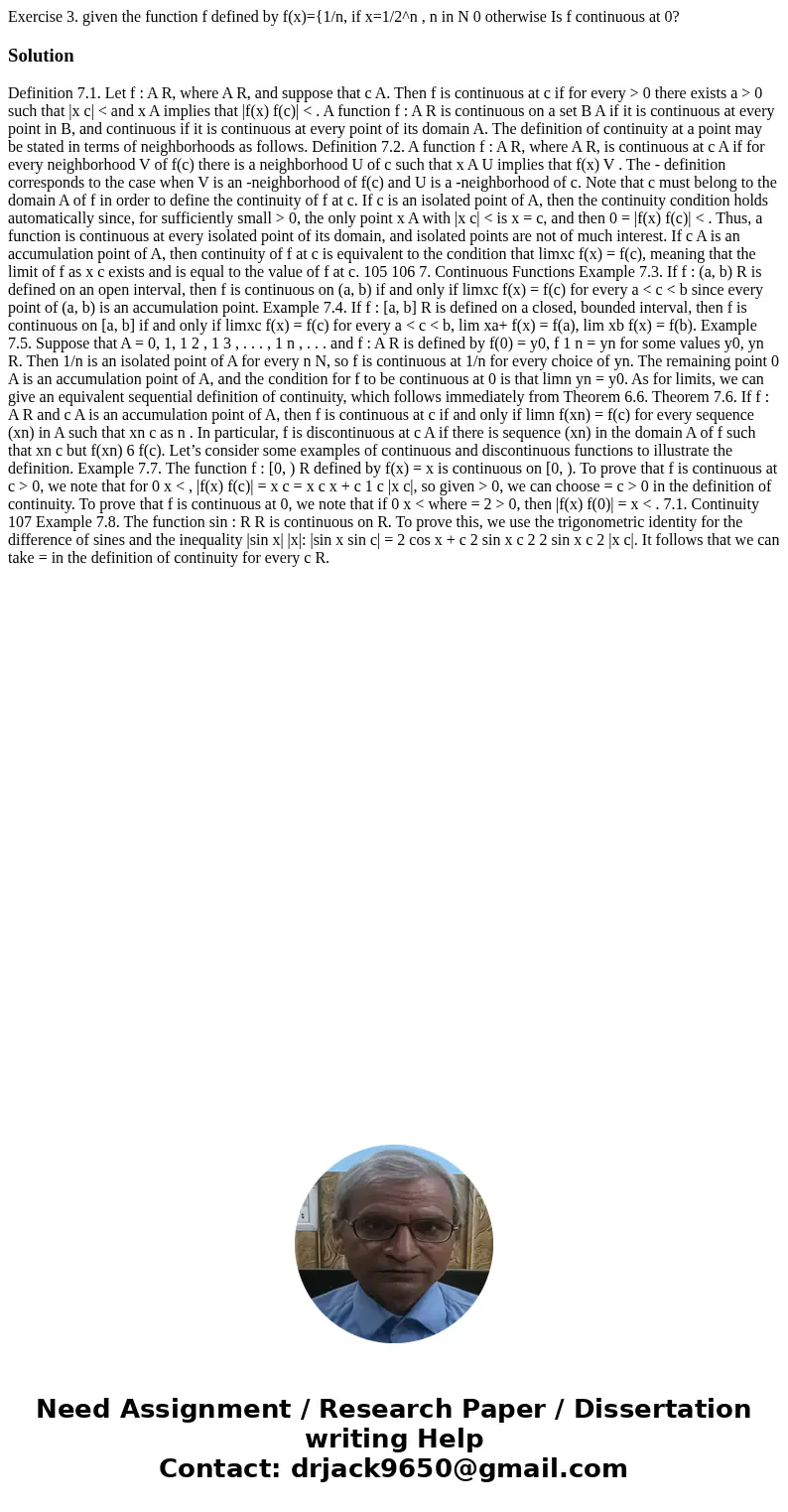Exercise 3 given the function f defined by fx1n if x12n n i
Solution
Definition 7.1. Let f : A R, where A R, and suppose that c A. Then f is continuous at c if for every > 0 there exists a > 0 such that |x c| < and x A implies that |f(x) f(c)| < . A function f : A R is continuous on a set B A if it is continuous at every point in B, and continuous if it is continuous at every point of its domain A. The definition of continuity at a point may be stated in terms of neighborhoods as follows. Definition 7.2. A function f : A R, where A R, is continuous at c A if for every neighborhood V of f(c) there is a neighborhood U of c such that x A U implies that f(x) V . The - definition corresponds to the case when V is an -neighborhood of f(c) and U is a -neighborhood of c. Note that c must belong to the domain A of f in order to define the continuity of f at c. If c is an isolated point of A, then the continuity condition holds automatically since, for sufficiently small > 0, the only point x A with |x c| < is x = c, and then 0 = |f(x) f(c)| < . Thus, a function is continuous at every isolated point of its domain, and isolated points are not of much interest. If c A is an accumulation point of A, then continuity of f at c is equivalent to the condition that limxc f(x) = f(c), meaning that the limit of f as x c exists and is equal to the value of f at c. 105 106 7. Continuous Functions Example 7.3. If f : (a, b) R is defined on an open interval, then f is continuous on (a, b) if and only if limxc f(x) = f(c) for every a < c < b since every point of (a, b) is an accumulation point. Example 7.4. If f : [a, b] R is defined on a closed, bounded interval, then f is continuous on [a, b] if and only if limxc f(x) = f(c) for every a < c < b, lim xa+ f(x) = f(a), lim xb f(x) = f(b). Example 7.5. Suppose that A = 0, 1, 1 2 , 1 3 , . . . , 1 n , . . . and f : A R is defined by f(0) = y0, f 1 n = yn for some values y0, yn R. Then 1/n is an isolated point of A for every n N, so f is continuous at 1/n for every choice of yn. The remaining point 0 A is an accumulation point of A, and the condition for f to be continuous at 0 is that limn yn = y0. As for limits, we can give an equivalent sequential definition of continuity, which follows immediately from Theorem 6.6. Theorem 7.6. If f : A R and c A is an accumulation point of A, then f is continuous at c if and only if limn f(xn) = f(c) for every sequence (xn) in A such that xn c as n . In particular, f is discontinuous at c A if there is sequence (xn) in the domain A of f such that xn c but f(xn) 6 f(c). Let’s consider some examples of continuous and discontinuous functions to illustrate the definition. Example 7.7. The function f : [0, ) R defined by f(x) = x is continuous on [0, ). To prove that f is continuous at c > 0, we note that for 0 x < , |f(x) f(c)| = x c = x c x + c 1 c |x c|, so given > 0, we can choose = c > 0 in the definition of continuity. To prove that f is continuous at 0, we note that if 0 x < where = 2 > 0, then |f(x) f(0)| = x < . 7.1. Continuity 107 Example 7.8. The function sin : R R is continuous on R. To prove this, we use the trigonometric identity for the difference of sines and the inequality |sin x| |x|: |sin x sin c| = 2 cos x + c 2 sin x c 2 2 sin x c 2 |x c|. It follows that we can take = in the definition of continuity for every c R.

 Homework Sourse
Homework Sourse